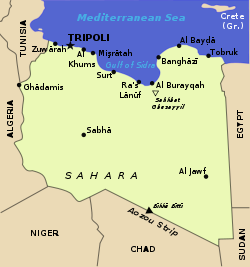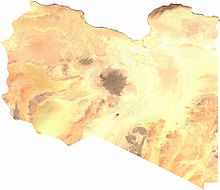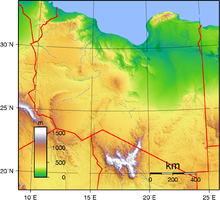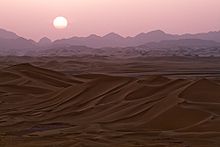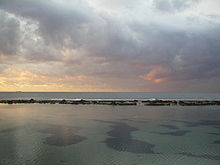- Geography of Libya
-
Coordinates: 25°00′N 17°00′E / 25°N 17°E
Libya is fourth in size among the countries of Africa and seventeenth among the countries of the world. Its coastline lies between Egypt and Tunisia. Although the oil discoveries of the 1960s have brought it immense petroleum wealth, at the time of its independence it was an extremely poor desert state whose only important physical asset appeared to be its strategic location at the midpoint of Africa's northern rim. It lay within easy reach of the major European nations and linked the Arab countries of North Africa with those of the Middle East, facts that throughout history had made its urban centers bustling crossroads rather than isolated backwaters without external social influences. Consequently, an immense social gap developed between the cities, cosmopolitan and peopled largely by foreigners, and the desert hinterland, where tribal chieftains ruled in isolation and where social change was minimal.
Contents
Geographical summary
The Mediterranean coast and the Sahara Desert are the country's most prominent natural features. There are several highlands but no true mountain ranges except in the largely empty southern desert near the Chadian border, where the Tibesti Massif rises to over 2,200 meters. A relatively narrow coastal strip and highland steppes immediately south of it are the most productive agricultural regions. Still farther south a pastoral zone of sparse grassland gives way to the vast Sahara Desert, a barren wasteland of rocky plateaus and sand. It supports minimal human habitation, and agriculture is possible only in a few scattered oases.
Between the productive lowland agricultural zones lies the Gulf of Sidra, where along the coast a stretch of 500 kilometers of wasteland desert extends northward to the sea. This barren zone, known as the Sirtica, has great historical significance. To its west, the area known as Tripolitania has characteristics and a history similar to those of nearby Tunisia, Algeria, and Morocco. It is considered with these states to constitute a supranational region called the Maghrib. To the east, the area known historically as Cyrenaica has been closely associated with the Arab states of the Middle East. In this sense, the Sirtica marks the dividing point between the Maghrib and the Mashriq.
Along the shore of Tripolitania for more than 300 kilometers, coastal oases alternate with sandy areas and lagoons. Inland from these lies the Jifarah Plain, a triangular area of some 15,000 square kilometers. About 120 kilometers inland the plain terminates in an escarpment that rises to form the Nafusa Mountains, with elevations of up to 1,000 meters, which is the northern edge of the Tripolitanian Plateau.[1]
In Cyrenaica there are fewer coastal oases, and the Marj Plain – the lowland area corresponding to the Jifarah Plain of Tripolitania – covers a much smaller area. The lowlands form a crescent about 210 kilometers long between Benghazi and Derna and extend inland a maximum of 50 kilometers. Elsewhere along the Cyrenaican coast, the precipice of an arid plateau reaches to the sea. Behind the Marj Plain, the terrain rises abruptly to form Jabal al Akhdar (Green Mountain), so called because of its leafy cover of pine, juniper, cypress, and wild olive. It is a limestone plateau with maximum altitudes of about 900 meters. From Jabal al Akhdar, Cyrenaica extends southward across a barren grazing belt that gives way to the Sahara Desert, which extends still farther southwest across the Chadian frontier. Unlike Cyrenaica, Tripolitania does not extend southward into the desert. The southwestern desert, known as Fezzan, was administered separately during both the Italian regime and the federal period of the Libyan monarchy. In 1969 the revolutionary government officially changed the regional designation of Tripolitania to Western Libya, of Cyrenaica to Eastern Libya, and of Fezzan to Southern Libya; however, the old names were intimately associated with the history of the area, and during the 1970s they continued to be used frequently. Cyrenaica comprises 51%, Fezzan 33%, and Tripolitania 16% of the country's area.
Before Libya achieved independence, its name was seldom used other than as a somewhat imprecise geographical expression. The people preferred to be referred to as natives of one of the three constituent regions. The separateness of the regions is much more than simply geographical and political, for they have evolved largely as different socioeconomic entities – each with a culture, social structure, and values different from the others. Cyrenaica became Arabized at a somewhat earlier date than Tripolitania, and Beduin tribes dominated it. The residual strain of the indigenous Berber inhabitants, however, still remains in Tripolitania. Fezzan has remained a kind of North African outback, its oases peopled largely by minority ethnic groups.
The border between Tripolitania and Tunisia is subject to countless crossings by legal and illegal migrants. No natural frontier marks the border, and the ethnic composition, language, value systems, and traditions of the two peoples are nearly identical. The Cyrenaica region is contiguous with Egypt, and here, too, the border is not naturally defined; illegal as well as legal crossings are frequent. In contrast, Fezzan's borders with Algeria, Niger, and Chad are seldom crossed because of the almost total emptiness of the desert countryside.
Other factors, too, such as the traditional forms of land tenure, have varied in the different regions. In the 1980s their degrees of separateness was still sufficiently pronounced to represent a significant obstacle to efforts toward achieving a fully unified Libya.
Area and boundaries
Area:
total: 1 759 540 km²
land: 1 759 540 km²
water: 0 km²Area - comparative: Libya is the fourth largest country in Africa, seven times the size of the United Kingdom, and slightly larger than Alaska
Land boundaries:
total: 4 383 km
border countries: Algeria 982 km, Chad 1 055 km, Egypt 1 150 km, Niger 354 km, Sudan 383 km, Tunisia 459 kmCoastline: 1 770 km
Maritime claims:
territorial sea: 12 nmi (22.2 km; 13.8 mi)
note: Gulf of Sidra closing line – 32 degrees 30 minutes north.Climate and hydrology
 The Jabal Al Akdhar area. Annual rainfall averages at between 400 and 600 millimetres (15.7 and 23.6 in).[2]
The Jabal Al Akdhar area. Annual rainfall averages at between 400 and 600 millimetres (15.7 and 23.6 in).[2]
Within Libya as many as five different climatic zones have been recognized, but the dominant climatic influences are Mediterranean and Saharan. In most of the coastal lowland, the climate is Mediterranean, with warm summers and mild winters. Rainfall is scanty. The weather is cooler in the highlands, and frosts occur at maximum elevations. In the desert interior the climate has very hot summers and extreme diurnal temperature ranges. The highest official temperature ever recorded was on 13 September 1922 at 'Aziziya, Libya,[3] but that reading is queried.
Less than 2% of the national territory receives enough rainfall for settled agriculture, the heaviest precipitation occurring in the Jabal al Akhdar zone of Cyrenaica, where annual rainfall of 400 to 600 millimeters (15.7 to 23.6 in) is recorded. All other areas of the country receive less than 400 millimeters (15.7 in), and in the Sahara 50 millimeters (1.97 in) or less occurs. Rainfall is often erratic, and a pronounced drought may extend over two seasons. For example, epic floods in 1945 left Tripoli underwater for several days, but two years later an unprecedentedly severe drought caused the loss of thousands of head of cattle.
Deficiency in rainfall is reflected in an absence of permanent rivers or streams, and the approximately twenty perennial lakes are brackish or salty. In 1987 these circumstances severely limited the country's agricultural potential as a basis for the sound and varied economy Gaddafi sought to establish. The allocation of limited water is considered of sufficient importance to warrant the existence of the Secretariat of Dams and Water Resources, and damaging a source of water can be punished by a heavy fine or imprisonment.
The government has constructed a network of dams in wadis, dry watercourses that become torrents after heavy rains. These dams are used both as water reservoirs and for flood and erosion control. The wadis are heavily settled because soil in their bottoms is often suitable for agriculture, and the high water table in their vicinity makes them logical locations for digging wells. In many wadis, however, the water table is declining at an alarming rate, particularly in areas of intensive agriculture and near urban centers. The government has expressed concern over this problem and because of it has diverted water development projects, particularly around Tripoli, to localities where the demand on underground water resources is less intense. It has also undertaken extensive reforestation projects.
There are also numerous springs, those best suited for future development occurring along the scarp faces of the Jabal Nafusah and the Jabal al Akhdar. The most talked-about of the water resources, however, are the great subterranean aquifers of the desert. The best known of these lies beneath Kufra Oasis in southeastern Cyrenaica, but an aquifer with even greater reputed capacity is located near the oasis community of Sabha in the southwestern desert. In the late 1970s, wells were drilled at Kufra and at Sabha as part of a major agricultural development effort. An even larger undertaking is the so-called Great Manmade River, initiated in 1984. It is intended to tap the tremendous aquifers of the Kufra, Sarir, and Sabha oases and to carry the resulting water to the Mediterranean coast for use in irrigation and industrial projects.
Terrain and land use
Terrain: mostly barren, flat to undulating plains, plateaus, depressions
Elevation extremes:
lowest point: Sabkhat Ghuzayyil -47 m
highest point: Bikku Bitti 2 267 mNatural resources: petroleum, natural gas, gypsum
Land use:
arable land: 1%
permanent crops: 0%
permanent pastures: 8%
forests and woodland: 0%
other: 91% (1993 est.)Irrigated land: 4 700 km² (1993 est.)
Environmental concerns
Natural hazards: hot, dry, dust-laden ghibli is a southern wind lasting one to four days in spring and fall; dust storms, sandstorms
Environment - current issues: desertification; very limited natural fresh water resources; the Great Manmade River Project, the largest water development scheme in the world, is being built to bring water from large aquifers under the Sahara to coastal cities
Environment - international agreements:
party to: Climate Change, Desertification, Marine Dumping, Nuclear Test Ban, Ozone Layer Protection
signed, but not ratified: Biodiversity, Law of the SeaExtreme points
This is a list of the extreme points of Libya, the points that are farther north, south, east or west than any other location.
- Northern-most point – Ras Ajdir at the point where the border with Tunisia enters the Mediterranean Sea, Nuqat al Khams District
- Eastern-most point – Marsa er Ramla at the point where the border with Egypt enters the Mediterranean Sea, Butnan District
- Southern-most point - the tripoint with Chad and Sudan, Kufra District
- Western-most point - unnamed point on the border with Algeria immediately east of Ghadames, Nalut District
See also
- Cyrenaica
- Fezzan
- List of cities in Libya
- Tripolitania
- Transliteration of Libyan placenames
Notes
- ^ Barich, B. E.; Garcea, E. A.A. and Giraudi, C. (2006) "Between the Mediterranean and the Sahara: Geoarchaeological reconnaissance in the Jebel Gharbi, Libya" Antiquity 80(309): pp. 567–582
- ^ Federal Research Division of the Library of Congress, (1987), "Climate & Hydrology of Libya", U.S. Library of Congress. Retrieved July 15, 2006.
- ^ NASA
References
 This article incorporates public domain material from websites or documents of the Library of Congress Country Studies.
This article incorporates public domain material from websites or documents of the Library of Congress Country Studies.
External links
Libya topics History Ancient Libya · Roman Libya · Islamic Tripolitania and Cyrenaica · Ottoman Libya · Italian colony · Italian Libya · Allied occupation · Kingdom of Libya · Libya under Gaddafi · Civil War
Geography Cities · Climate · Districts · Ecoregions · Libyan Desert · Subdivisions · Wildlife
Politics Constitution · Elections · Foreign relations of the Libyan Arab Jamahiriya · Foreign relations of the National Transitional Council · General People's Committee · General People's Congress · Heads of State · Heads of Government · Human rights (LGBT rights) · International rankings · Jamahiriya · Military (Gaddafi authorities) · National Transitional Council · National Liberation Army
Economy Culture Demographics · Education · Health · Islam in Libya · Libyan Arabic · Literature · Media · Music · Public holidays · Religion · Sport · Tourism · Women
Sovereign
states- Algeria
- Angola
- Benin
- Botswana
- Burkina Faso
- Burundi
- Cameroon
- Cape Verde
- Central African Republic
- Chad
- Comoros
- Democratic Republic of the Congo
- Republic of the Congo
- Côte d'Ivoire (Ivory Coast)
- Djibouti
- Egypt
- Equatorial Guinea
- Eritrea
- Ethiopia
- Gabon
- The Gambia
- Ghana
- Guinea
- Guinea-Bissau
- Kenya
- Lesotho
- Liberia
- Libya
- Madagascar
- Malawi
- Mali
- Mauritania
- Mauritius
- Morocco
- Mozambique
- Namibia
- Niger
- Nigeria
- Rwanda
- São Tomé and Príncipe
- Senegal
- Seychelles
- Sierra Leone
- Somalia
- South Africa
- South Sudan
- Sudan
- Swaziland
- Tanzania
- Togo
- Tunisia
- Uganda
- Zambia
- Zimbabwe
States with limited
recognition- Sahrawi Arab Democratic Republic
- Somaliland
Dependencies and
other territories- Canary Islands / Ceuta / Melilla / Plazas de soberanía (Spain)
- Madeira (Portugal)
- Mayotte / Réunion (France)
- Saint Helena / Ascension Island / Tristan da Cunha (United Kingdom)
- Western Sahara
Climate of Africa Sovereign
states- Algeria
- Angola
- Benin
- Botswana
- Burkina Faso
- Burundi
- Cameroon
- Cape Verde
- Central African Republic
- Chad
- Comoros
- Democratic Republic of the Congo
- Republic of the Congo
- Côte d'Ivoire (Ivory Coast)
- Djibouti
- Egypt
- Equatorial Guinea
- Eritrea
- Ethiopia
- Gabon
- The Gambia
- Ghana
- Guinea
- Guinea-Bissau
- Kenya
- Lesotho
- Liberia
- Libya
- Madagascar
- Malawi
- Mali
- Mauritania
- Mauritius
- Morocco
- Mozambique
- Namibia
- Niger
- Nigeria
- Rwanda
- São Tomé and Príncipe
- Senegal
- Seychelles
- Sierra Leone
- Somalia
- South Africa
- South Sudan
- Sudan
- Swaziland
- Tanzania
- Togo
- Tunisia
- Uganda
- Zambia
- Zimbabwe
States with limited
recognition- Sahrawi Arab Democratic Republic
- Somaliland
Dependencies and
other territories- Canary Islands / Ceuta / Melilla / Plazas de soberanía (Spain)
- Madeira (Portugal)
- Mayotte / Réunion (France)
- Saint Helena / Ascension Island / Tristan da Cunha (United Kingdom)
- Western Sahara
Categories:
Wikimedia Foundation. 2010.

